Last Year I Used To Sleep From 5 Am To 10 Am Every Day And It Was Not Good For Me. I’ve Gotten A Couple





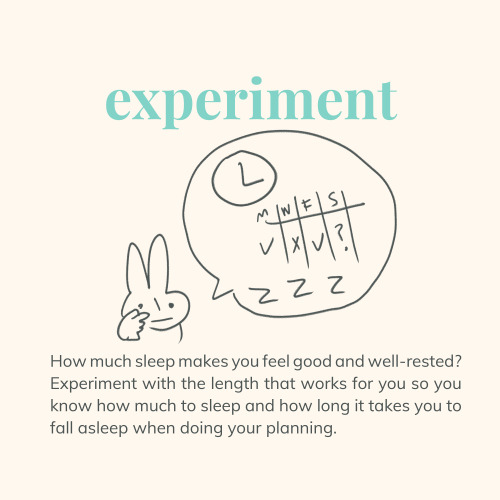


last year i used to sleep from 5 am to 10 am every day and it was Not Good for me. i’ve gotten a couple of questions about my sleep schedule so i thought i’d share some tips that helped me adopt a healthier sleep schedule. enjoy 🛏💤
More Posts from Isang--mag-aaral and Others

180611
We received our report cards for the first semester today. Most of my grades remained the same from the midterms all through out finals. One subject decreased drastically, but there were few marks that increased. I'm happy with the results, but I know that I can do better than that. Second sem will definitely be better, I will make it better. Let's do our best! :--))
january is one of those months where you experience every feeling on the human spectrum and you just have to go about your day like that isn't happening
15 steps on making a sweet sweet powerpoint presentation*
*for class presentations and seminars, like at conferences or meetings. Lecture notes for teaching are different, though some of these may still apply:
Tell a story. A story always has 3 parts: a beginning, a middle, and an end. Create a compelling narrative so the audience feels invested in knowing what’s next.
Know your audience, and adjust accordingly. Presenting to people with our same background (like students in our program) will differ from presenting to a broader audience like the general public, who may not care (or understand) nitty gritty detail.
Use large readable font. Especially on graphs and figures, and..
Limit text. A busy intimidating slide = a distracted/zoned out audience
Refrain from using pastel colors with a white background, or dark colors with a dark background. Projectors =/= your computer screen, and these colors may not have the same contrast during a presentation.
Also related, be considerate of the color-blind/visually impaired. Make figures accessible to them by not just relying on color but also patterns, shading, symbols, etc.
Show only what’s necessary. Try not to overwhelm an audience who’s seeing all this for the first time. Always remember: presentations are not data dumps; they’re stories. Simplify figures by remaking them if possible, or block out unimportant areas.
And walk the audience through complicated slides. We should never assume everyone in the audience knows exactly what we’re talking about. Use animations to show only one point or figure at a time if necessary.
Speaking of figures, use high-quality ones! None of the deep fried-jpegs please.
Also refrain from putting things that have no meaning. Examples include gratuitous eye candy (which are only acceptable in title and closing slides) or points that won’t be talked about. They’re just distracting.
Show interest when speaking. If the speaker sounds bored talking about their work, then I assume it’s boring and not worth my attention.
Refrain from going wild with that laser pointer. It’s there to bring attention to certain key points, not to continuously circle around the entire slide like we’re playing with cats. (If your hand holding the pointer is shaking, it helps to grab your wrist with your other free hand, or rest that arm on something (like the podium) to “root” it.)
Refrain from going wild with the animations/transitions also. Super cool in 4th grade; slightly nauseating at a national meeting. A simple “appear” animation will do just fine.
Rehearse rehearse rehearse. Being well-prepared can combat stage-fright, as it takes away the anxiety of “not knowing what to do next” or “mental freezes”. You may also find yourself editing a few things as you rehearse, because something that seemed ok while making the ppt may not flow so well when you actually get to talking about it. Also, pay attention to the usage of filler words (like “um”, “sorta”), and body language: are you leaning on the podium too much? pacing a lot? looking at the screen and not the audience?
Adopt a “power pose” to instantly feel more confident and relaxed. Stand up straight, chest out, shoulders back, uncross those arms, and smile. Hold yourself up like royalty, baby! Here’s a TedTalk on power poses.
a fools guide to not wanting to die anymore
by me, a fool who doesnt wanna die anymore
never make a suicide joke again. yes this includes “i wanna die” as a figure of speech. swear off of it. actually make an effort to change how you think about things.
find something to compliment someone for at least 4 times a day. notice the little things about the world that make you happy, and use that to make other people happy.
talk to people. initiate conversation as often as you possibly can. keep your mind busy and you wont have to worry anymore
picture the bad intrusive thoughts in youe head as an edgy 13 year old and tell them to go be emo somewhere else
if someone makes you feel bad most of the time, stop talking to them. making yourself hang out with people who drain you is self harm. stop it.
what are your twenties if not an endless string of the ghosts of who you thought you would become
yemen and how to help
help save yemen linktree
two links with more links and resources to help yemen, including what to read to know more, where to donate, petitions to sign, etc.
Any tips on how to study maths?
Here are a few things that might help:
how to memorise information effectively
how to math
how to study for maths
how to study for maths (2)
studying and exam tips for maths
studying maths
10 tips to excel in maths
xx







Art prints by KOMBOH. Collect them all!

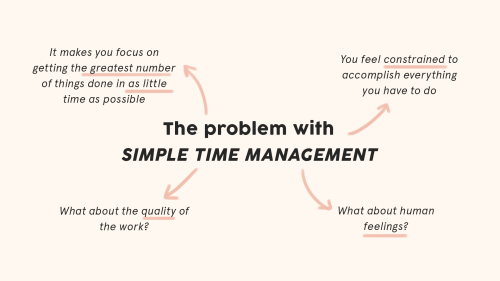
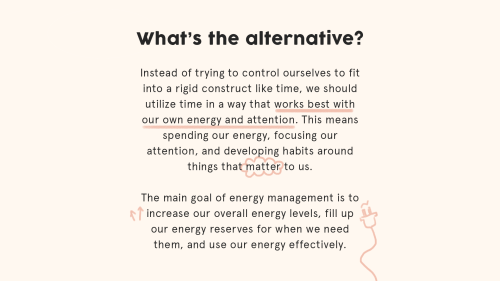
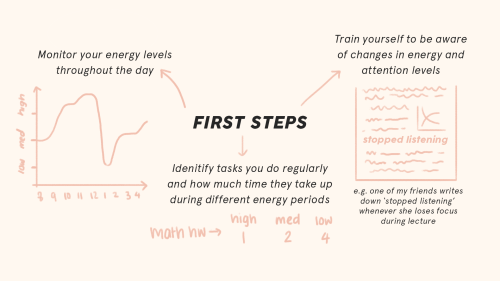
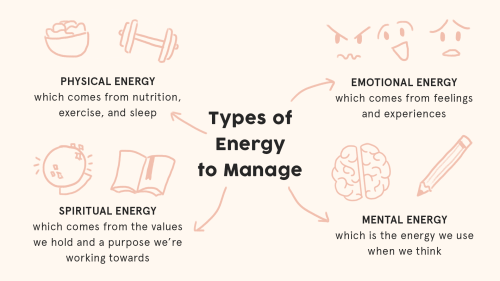
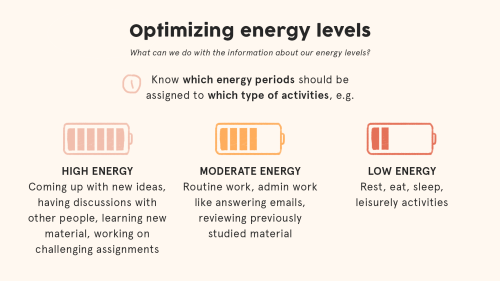
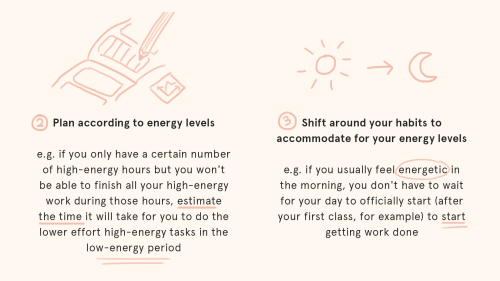
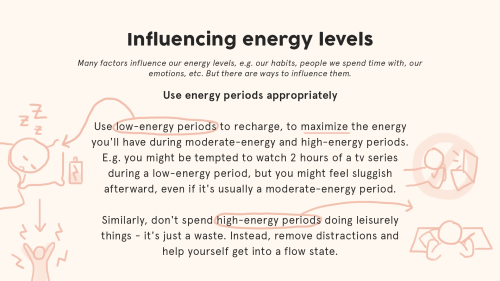
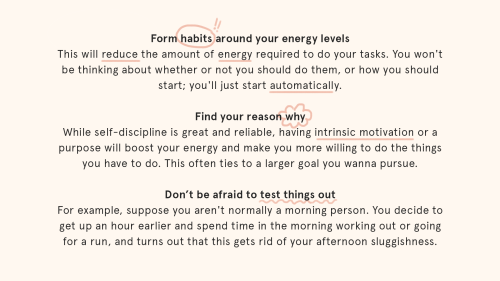
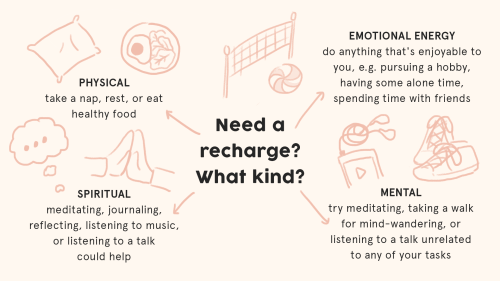
Energy Management
A human-based organization method
click on images for better resolution; images also available here (link to google drive)
Other posts that may be of interest:
Getting stuff done: How to deal with a lack of motivation
Flexible time-blocking: A more breathable way to get things done
The ABCDE Method
-
 nefarious-virgo reblogged this · 2 weeks ago
nefarious-virgo reblogged this · 2 weeks ago -
 owlask liked this · 1 month ago
owlask liked this · 1 month ago -
 alwaysthefirstsight liked this · 2 months ago
alwaysthefirstsight liked this · 2 months ago -
 organised-kitty liked this · 4 months ago
organised-kitty liked this · 4 months ago -
 study-with-cait liked this · 4 months ago
study-with-cait liked this · 4 months ago -
 hotdogmeat liked this · 4 months ago
hotdogmeat liked this · 4 months ago -
 sidebyside-withafriend reblogged this · 5 months ago
sidebyside-withafriend reblogged this · 5 months ago -
 swanstiel liked this · 5 months ago
swanstiel liked this · 5 months ago -
 earl-grey-crow reblogged this · 5 months ago
earl-grey-crow reblogged this · 5 months ago -
 garbagecannon reblogged this · 5 months ago
garbagecannon reblogged this · 5 months ago -
 garbagecannon liked this · 5 months ago
garbagecannon liked this · 5 months ago -
 isfjmel-phleg liked this · 5 months ago
isfjmel-phleg liked this · 5 months ago -
 lovesodeepandwideandwell liked this · 5 months ago
lovesodeepandwideandwell liked this · 5 months ago -
 brown-little-robin reblogged this · 5 months ago
brown-little-robin reblogged this · 5 months ago -
 revultist liked this · 5 months ago
revultist liked this · 5 months ago -
 juljanda liked this · 5 months ago
juljanda liked this · 5 months ago -
 sprxng-flower liked this · 5 months ago
sprxng-flower liked this · 5 months ago -
 flickertheory liked this · 5 months ago
flickertheory liked this · 5 months ago -
 langivi liked this · 5 months ago
langivi liked this · 5 months ago -
 ros3ybabe liked this · 5 months ago
ros3ybabe liked this · 5 months ago -
 nowtoboldlygo reblogged this · 5 months ago
nowtoboldlygo reblogged this · 5 months ago -
 silly-mode-cilia reblogged this · 5 months ago
silly-mode-cilia reblogged this · 5 months ago -
 imhereandgenderqueer reblogged this · 5 months ago
imhereandgenderqueer reblogged this · 5 months ago -
 imhereandgenderqueer liked this · 5 months ago
imhereandgenderqueer liked this · 5 months ago -
 edge-squire liked this · 5 months ago
edge-squire liked this · 5 months ago -
 kashaknish reblogged this · 5 months ago
kashaknish reblogged this · 5 months ago -
 king-ghidorah reblogged this · 5 months ago
king-ghidorah reblogged this · 5 months ago -
 king-ghidorah liked this · 5 months ago
king-ghidorah liked this · 5 months ago -
 dilfphd liked this · 5 months ago
dilfphd liked this · 5 months ago -
 marry-and-mirthful liked this · 5 months ago
marry-and-mirthful liked this · 5 months ago -
 stars-on-marss liked this · 5 months ago
stars-on-marss liked this · 5 months ago -
 hauntlr liked this · 5 months ago
hauntlr liked this · 5 months ago -
 izziwitch liked this · 5 months ago
izziwitch liked this · 5 months ago -
 useless-immortal reblogged this · 5 months ago
useless-immortal reblogged this · 5 months ago -
 useless-immortal liked this · 5 months ago
useless-immortal liked this · 5 months ago -
 milklesstea reblogged this · 5 months ago
milklesstea reblogged this · 5 months ago -
 acecasinova reblogged this · 5 months ago
acecasinova reblogged this · 5 months ago -
 friendofpariah reblogged this · 5 months ago
friendofpariah reblogged this · 5 months ago -
 redastrayzero reblogged this · 5 months ago
redastrayzero reblogged this · 5 months ago -
 zerobotic reblogged this · 5 months ago
zerobotic reblogged this · 5 months ago -
 artsymistey liked this · 5 months ago
artsymistey liked this · 5 months ago -
 wenchweek liked this · 5 months ago
wenchweek liked this · 5 months ago -
 thekitchenphilosopheress reblogged this · 5 months ago
thekitchenphilosopheress reblogged this · 5 months ago -
 cardioat3am liked this · 5 months ago
cardioat3am liked this · 5 months ago -
 iwasreading liked this · 5 months ago
iwasreading liked this · 5 months ago -
 jaiofalltrades liked this · 5 months ago
jaiofalltrades liked this · 5 months ago
